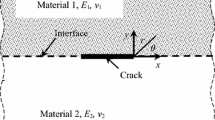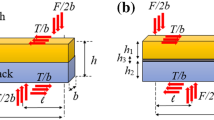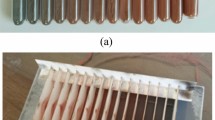Abstract
The interfacial fracture in bimaterial and functionally graded material (FGM) under impact loading conditions is investigated using experimental and numerical techniques that are valid for both type of interfaces. Experiments are conducted on epoxy based specimens in three point bend configuration and the complex SIF is measured using an electrical strain gage mounted close to the crack-tip. A complementary two-dimensional finite element simulation is performed using tup force and support reactions as input tractions, and the SIF-time history is determined using a displacement extrapolation technique. The experimentally determined SIF-histories match closely with numerical simulation up to the time of fracture initiation. The test results show that the mode-mixity remains nearly constant through out the test in both the materials, and the mixity values correspond to their respective static counterparts. The general dynamic response of the bimaterial and FGM specimens in terms of impact load, support reaction and the magnitude of complex SIF are comparable, and the mode-mixity is the parameter that distinguishes the graded interface from the bimaterial case.
Similar content being viewed by others
References
Cao, H.C. and Evans, A.G. (1989). Experimental study of the fracture resistance of bimaterial interfaces. Mechanics of Materials 7, 295–304.
Charalambides, P.G., Lund, J., Evans, A.G. and McMeeking, R.M. (1989). A test specimen for determining the fracture resistance of bimaterial interfaces. Journal of Applied Mechanics 56, 77–82.
Erdogan, F., (1995). Fracture mechanics of functionally graded materials. Composites Engineering, 5, 753–770.
Fukui, Y., Yamanaka, N. and Enokida, Y. (1997). Bending strength of an Al-Al3Ni functionally graded material Composites B: Engineering 28, 37–43.
Jin, Z.-H. and Noda, N. (1993). An internal crack parallel to the boundary of a non-homogeneous half plane under thermal loading. International Journal Engineering Science 31 793–806.
Liu, C., Lambros, J. and Rosakis, A.J. (1993). Highly transient elastodynamics crack growth in a bimaterial interface: Higher order asymptotic analysis and optical measurements. Journal of the Mechanics and Physics of Solids 41, 1857–954.
Marur, P.R. and Tippur, H.V. (1999a). A strain gage method for determination of fracture parameters in bimaterial systems. Engineering Fracture Mechanics, Vol. 64, No. 1, pp. 87–104.
Marur, P.R. and Tippur, H.V. (1999b). Numerical analysis of crack-tip fields in functionally graded materials with a crack normal to the elastic gradient. International Journal of Solids and Structures (to appear).
Marur, P.R. and Tippur, H.V. (1998). Evaluation of mechanical properties of functionally graded materials. Journal of Testing and Evaluation 26, 539–545.
O'Dowd, N.P., Shih, C.F. and Stout, M.G. (1992). Test geometries for measuring interfacial fracture toughness. International Journal of Solids and Structures 29, 571–589.
Parameswaran, V. and Shukla, A. (1998). Dynamic fracture of a functionally gradient material having discrete property variation, Journal of Materials Science 33, 3303–3311.
Rice, J.R. (1998). Elastic fracture mechanics concepts for interface crack, Journal of Applied Mechanics 55, 98–103.
Sarkar, P., Datta, S. and Nicholson, P.S. (1997). Functionally graded ceramic/ceramic and metal/ceramic composites by electrophoretic deposition. Composites B: Engineering, 28, 49–56.
Singh, R.P. and Shukla, A. (1997). Subsonic and transonic crack growth along a bimaterial interfaces. International Journal of Solids and Structures 83, 291–304.
Sinha, J.K., Tippur, H.V. and Xu, L. (1997). An interferometric and finite element investigation of interfacial crack-tip fields: Role of mode-mixity on 3-dimensional stress variations. International Journal of Solids and Structures 34, 741–754.
Sun, C.T. and Jih, C.J. (1987). On strain energy release rates for interfacial cracks in bi-material media. Engineering Fracture Mechanics 28, 13–20.
Thau, S.A. and Liu, T.H. (1971). Transient stress intensity factors for a finite crack in an elastic solid caused by a dilatational wave. International Journal of Solids and Structures 7, 731–750.
Tippur, H.V. and Rosakis, A.J. (1991). Quasi-static and dynamic crack growth along bimaterial interfaces: A note on crack tip measurements using coherent gradient sensing. Experimental Mechanics 33, 243–252.
Yamanouchi, M., Koizumi, M., Hirai, T. and Shiota, I. (1990). FGM-90. Proc. First International Symposium onFunctionally Graded Materials, FGM Forum, Tokyo, Japan.
Author information
Authors and Affiliations
Rights and permissions
About this article
Cite this article
Marur, P.R., Tippur, H.V. Dynamic response of bimaterial and graded interface cracks under impact loading. International Journal of Fracture 103, 95–109 (2000). https://doi.org/10.1023/A:1007621303220
Issue Date:
DOI: https://doi.org/10.1023/A:1007621303220




